In today’s homes, saving space is vital. With living spaces shrinking, multifunctional furniture is no longer just convenient, but essential.
Whether you’re in a small apartment or simply aiming to maximise every inch, furniture that serves multiple purposes or provides extra storage is a smart solution.
Below, we’ll explore various types of space-saving beds ideal for small spaces, offering versatility and additional storage options.
Available in standard bed sizes, these multifunctional beds cater to all ages, from children to adults.
1. Bunk Beds
Bunk beds are a popular choice, especially for families with multiple children close in age, maximizing space by stacking beds. They typically feature a ladder and can have twin, double, or futon options.
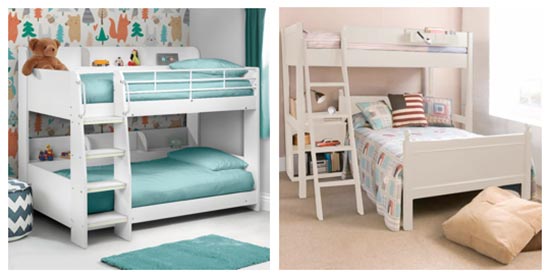
Wooden bunk beds for both younger (left) and older (right) children in two different styles – Images sourced from Happy Beds (left) and Nubie (right)
Bunk beds come in wood or metal, offering various styles. Modern designs are not just for sleeping but also for storage or desks. Some even accommodate three or four beds, maximising space efficiently.
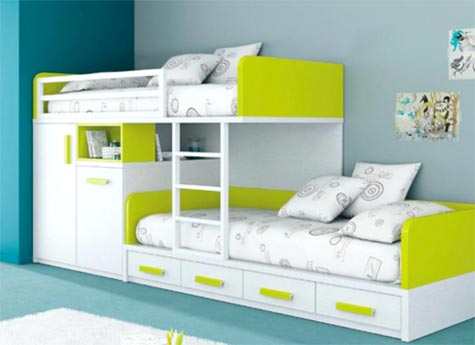
Bunk bed that incorporates storage space – Images sourced from Pinterest – Boards: Favourite Bunk Beds
Bunk beds are popular in kids’ and teenagers’ rooms, especially in shared spaces, maximising floor space for additional furniture. They’re also ideal for university halls or shared accommodations with limited floor area.
2. Lofted Beds
Like bunk beds, a lofted bed is a single bed raised above the floor on a frame or stilts, creating space underneath for storage, a study, or even another bed.
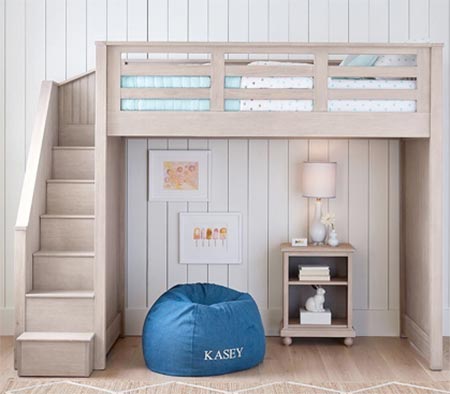
Timber framed lofted beds with ladder and steps and space underneath – Image sourced from Pinterest
Lofted beds, like bunk beds, save space by raising a single bed above the floor, allowing for multiple functions in one area.
They come in various designs and heights, from mid-risers up to high-risers.
Some feature built-in desks or shelves, while others offer just the frame for customisation.
Another type is integrated into the wall or ceiling, ideal for small spaces like studio flats. These beds maximise floor space, offering room underneath for living or office areas.
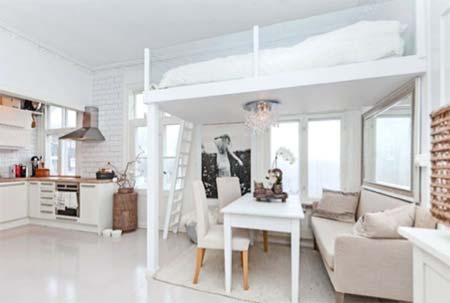
Lofted bed for adults to save space in small homes or studio flats – Image sourced from Home Décor
3. Cabin Beds
Cabin beds, like lofted beds, raise the sleeping area with storage space underneath.
Unlike lofted beds, cabin beds are typically lower or mid-rise and also any storage is integrated into the bed frame rather than separate.
Designs range from simple drawers and shelves to complex setups with built-in wardrobes, desks, and more, offering multi-functionality in a single piece of furniture.
A space-saving wonder!
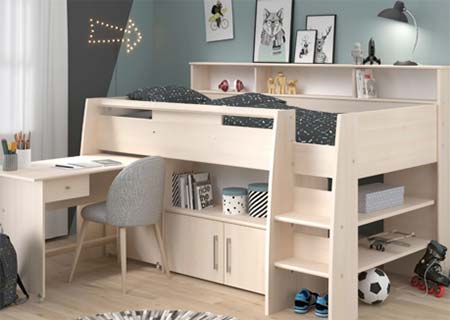
Cabin bed for younger with built-in storage space and study area – Image sourced from Happy Beds
Cabin beds, like lofted and bunk beds, are popular in kids’ and teens’ bedrooms, and useful again in cramped university halls.
They’re ideal for families with multiple small children sharing a room, offering individual storage space for clothes and toys, teaching responsibility. The remaining room becomes a communal play area for the children.
4. Trundle Beds
A trundle bed is stored under another and can be pulled out for guests. It’s often paired with bunk beds for an extra sleeping space, but can also accompany regular beds if there’s enough clearance underneath.
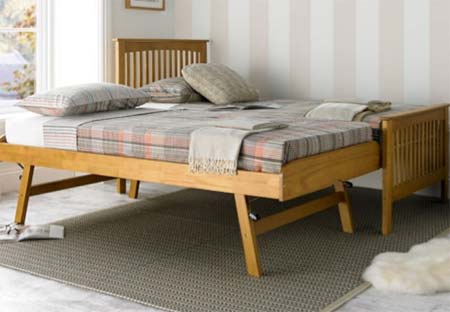
Trundle bed that can separate from the main bed frame and be a separate bed entirely – Image sourced from Ikea
In some trundle bed designs, the trundle is part of the main bed frame, while in others, it’s detachable. Legs can be pulled out or screwed on to raise the bed to a normal height, or they may stay low and attached to the main frame.
Trundle beds are a practical addition to kids’ rooms, especially for siblings sharing a space. They’re also great for sleepovers, eliminating the need for spare mattresses. Additionally, they provide extra sleeping space in guest rooms.
5. Murphy Beds
A Murphy bed, also known as a wall bed, is a mattress and frame unit, folded up and stored vertically or horizontally against a wall, easily pulled down when needed. Hydraulic hinges make it effortless to operate. Straps or bars keep the mattress and bedding in place when upright to prevent sagging.
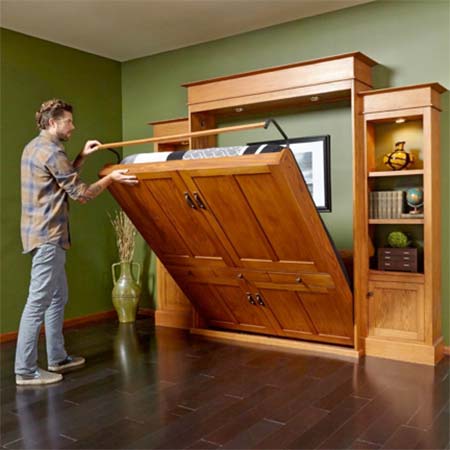
Murphy bed that folds up to look like an ordinary wardrobe and shelf set – Image sourced from Family Handyman
Murphy beds come in various designs and are available from various sellers, offering options from simple to elaborate.
There are DIY tutorials and kits available for making your own Murphy bed, including mechanisms and springs, a quick search online will reveal many of these.
They can be concealed inside a wardrobe or cupboard, either pre-built or a custom-made cupboard, seamlessly blending into the room’s decor.
Murphy beds are ideal for small, multipurpose rooms like home offices or studies that can also double as a guest bedroom, maximising space.
With the right mattress, these beds offer both comfort and functionality, making them a valuable addition to any home.
6. Cabinet Beds
Like Murphy beds, cabinet beds fold into a cabinet or chest when not in use, offering space-saving solutions.
Available in various designs, cabinet beds are ideal for smaller or multi-purpose rooms where drilling into walls isn’t possible, such as rented accommodations.
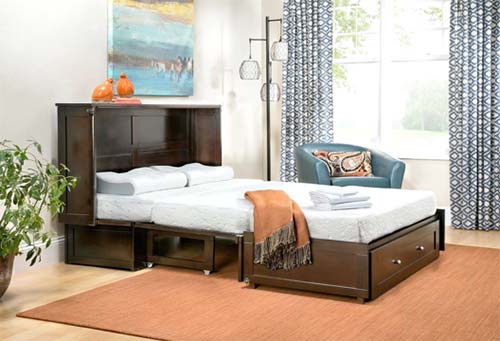
Cabinet beds that fold out when needed for sleeping – Image sourced from Slumberland
7. Folding Beds
Folding beds consist of a metal frame with mesh or wooden slats to support the mattress. They feature a pivot-and-lock mechanism for easy folding and secure locking, preventing accidental folding.
They can be stored behind a sofa, under a bed, or in a cupboard, remaining out of sight until needed. Where they can be stored does however depending on the size and mattress thickness.
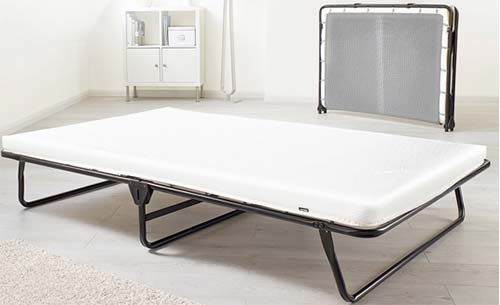
Large folding bed useful for a once-in-a-while sleeping solution – Image sourced from BedKingdom
Folding beds are not recommended for everyday use as it is not a comfortable long-term solution, but for one-off use now and then or for out-of-town guests or sleepovers it is a reliable option and preferable to sleeping on the floor.
8. Sofa Beds
Sofa beds are sofas that convert into beds, featuring a built-in frame and mattress that folds out from inside the sofa.
Available in various sizes, from single to queen, most sofa beds are double beds.
There are two main styles: one where the mattress and frame are stored under the seat cushions and can be pulled out, and another where the back of the sofa folds down to create the bed, using the sofa cushions as the mattress.
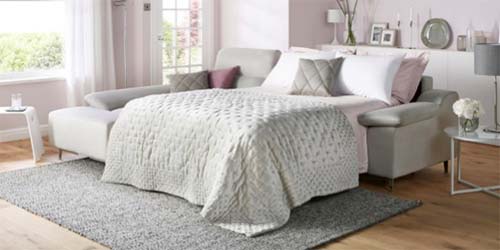
A sofa bed in a living room can be useful for out-of-town guests – Image sourced from DFS
Sofa beds are perfect for small homes or apartments without a spare bedroom. They resemble regular sofas and are comfortable in both sofa and bed positions.
Primarily found in living rooms or home offices, sofa beds are also popular among university students, offering a space-saving solution by combining a bed and sofa in one.
9. Futon Beds
Like sofa beds, futon beds feature a frame that folds down to lay flat. The futon mattress is unique, designed to fold to accommodate both sofa and bed configurations.
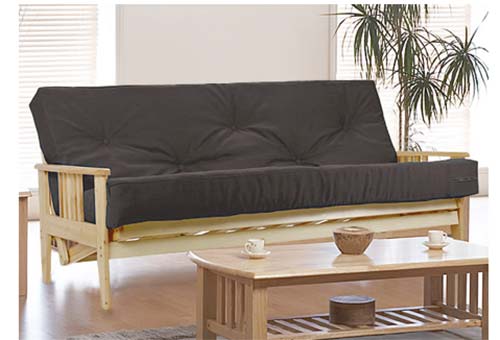
Western styled futon bed/sofa combo – Image sourced from Futon Sofa Beds Direct
While futons were once known for their discomfort and tendency to sag over time, modern versions offer improved comfort and durability. They serve as a versatile bed/sofa combo, especially popular among university students and first-time renters due to their affordability.
10. Divan Storage Beds
A divan storage bed features a platform base typically composed of two parts joined by brackets. It may have wheels or feet and often includes built-in drawers for under-bed storage, eliminating the need for extra storage furniture and saving space.
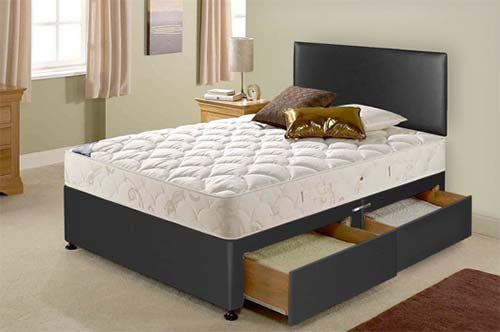
Divan based bed with drawers for under-bed storage – Image sourced from Costco
Divan beds offer convenient storage space hidden behind drawers or sliding doors.
There are two styles of divan bed bases: the traditional sprung edge and the modern platform top.
The sprung edge design features coil or pocket springs for cushioned support, while the platform top provides a firmer feel.
Available in standard mattress sizes, divan beds suit almost any bedroom and are particularly popular in master bedrooms or adolescent rooms for their simple design and practicality.
11. Ottoman Storage Beds
Ottoman beds, like divan beds, feature hidden storage within the frame.
The ottoman bed base allows easy lifting of the mattress, accessing the storage compartment without disturbing bedding or pillows.
Hydraulic hinges enable effortless lifting of the platform, requiring minimal effort and allowing the use of both hands when accessing the storage.
Unlike the divan base, an ottoman bed utilises the entire space under the mattress, sometimes divided into sections for better organisation.
Regardless of your choice, accessing the space is as easy as lifting the mattress. When you need to store something, simply lift the bed portion – space-saving at its best.
Like the divan, an ottoman bed suits any room and age group. However, if placed in a younger child’s room, ensure adult supervision for opening and closing to prevent accidents as there are springs and levers present that can easily trap and squash fingers and the likes!
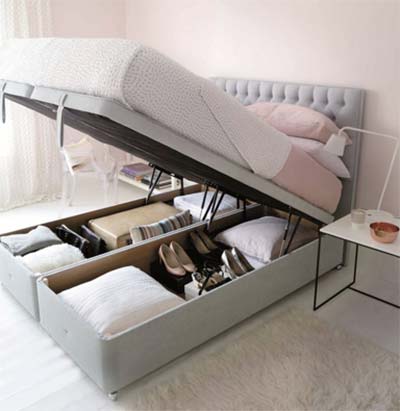
Divan-style Ottoman beds with separated storage spaces – Image sourced from Dreamland
12. Blowup/Inflatable Beds
Although they have been around for many years, they have never had that good a reputation for reliability, and most tended to slowly deflate during the night, leaving the occupant(s) on the floor by the morning.
In recent years, due to advancements in material and construction techniques, many on offer today offer a great temporary or guest bed solution.
Due to these improvements, most can now be inflated to much higher pressures and thus offer a much more comfortable nights sleep, not too far away from the levels provided by a standard bed.

Yawn inflatable bed
All the space-saving beds mentioned are readily available at bed and mattress retailers, both in-store and online.
Given the high demand for beds with extra storage, now is the perfect time to embrace this trend.
For those inclined towards DIY projects, numerous tutorials and plans are available for crafting your own versions of these beds. We encourage you to explore these options, as it not only saves money but also provides a rewarding sense of accomplishment.
We have plenty of projects on woodworking and carpentry, as well as in-depth knowledge on joinery which will be very helpful and valuable information if you were to ever decide to make a bunk bed for your children or a Murphy bed for the office/guest room.
Creating as much space as possible in any home is a great idea for many reasons, not just for storage but also for all important play space, especially in a bed room, so if a space saving bed can be incorporated, this is certainly something to think about.

